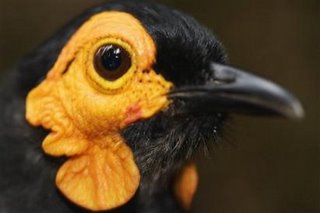
When you keep track of these things regularly, you tend to come across a higher percentage of "doom and gloom" stuff, so the story below makes for a nice change of pace.
JAKARTA, Indonesia (AP) - A team of scientists exploring an isolated jungle in one of Indonesia's most remote provinces said they discovered dozens of new species of frogs, butterflies and plants - as well as large mammals hunted to near extinction elsewhere.The team also found wildlife that were remarkably unafraid of humans during their rapid assessment survey of the Foja Mountains, which has more than a million hectares of old growth tropical forest, Bruce Beehler, a co-leader of the monthlong trip, said in announcing the discoveries Tuesday.
Two Long-Beaked Echidnas, a primitive egg-laying mammal, simply allowed scientists to pick them up and bring them back to their camp to be studied, he said.
Their findings, however, will have to be published and then reviewed by peers before being officially classified as new species, a process that could take six months to several years.
The December 2005 expedition to the eastern province of Papua was organized by the U.S.-based environmental organization Conservation International and the Indonesian Institute of Sciences.
"There was not a single trail, no sign of civilization, no sign of even local communities ever having been there," said Beehler, adding that two headmen from the Kwerba and Papasena tribes, the customary landowners of the Foja Mountains, accompanied the expedition.
"They were as astounded as we were at how isolated it was," he told The Associated Press in a telephone interview from Washington. "As far as they knew, neither of their clans had ever been to the area."
Papua, the scene of a decades-long separatist rebellion that has left an estimated 100,000 people dead, is one of Indonesia's most remote provinces, geographically and politically, and access by foreigners is tightly restricted.
The 11-member team of U.S., Indonesian and Australian scientists needed six permits before they could legally fly by helicopter to an open, boggy lakebed surrounded by forests near the range's western summit.
The scientists said they discovered 20 frog species - including a tiny microhylid frog less than two centimetres long - four new butterfly species, and at least five new types of palms.
Because of the rich diversity in the forest, the group rarely had to stray more than a few kilometres from their base camp.
"We've only scratched the surface," said Beehler, vice-president of Conservation International's Melanesia Center for Biodiversity Conservation, who hopes to return later this year with other scientists.
One of the most remarkable discoveries was the Golden-mantled Tree Kangaroo, an arboreal jungle-dweller new for Indonesia and previously thought to have been hunted to near extinction, and a new honeyeater bird, which has a bright orange face-patch with a pendant wattle under each eye, Beehler said.
One of the reasons for the rainforest's isolation, he said, was that only a few hundred people live in the region and game in the mountain's foothills was so abundant that they had no reason to venture into the jungle's interior.
There did not appear to be any immediate conservation threat to the area, which has the status of a wildlife sanctuary, he said.
"No logging permits are given to this area, there is no transport system - not a single road," Beehler said.
"But clearly with time everything is a threat. In the next few decades there will be strong demands, especially if you think of the timber needs of nearby countries like China and Japan. They will be very hungry for logs."

No comments:
Post a Comment